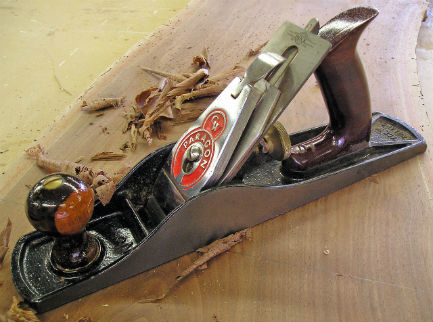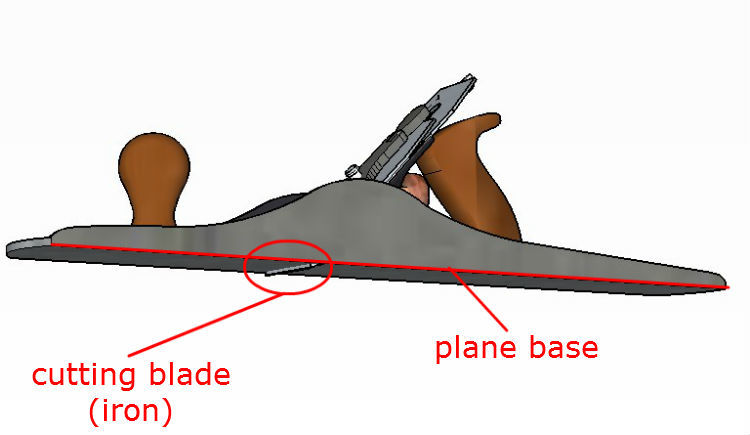Bench planes are still useful, even today but knowing what they are and how they work is probably the best place to start...
Makes sense... Right?
Planers are a little bit different and serve different purposes, even though they do the same thing...

If you have ever used a wood chisel, you would get the basic principles for a planer. It works the same way a chisel would but has a "frame" to it with handles, giving you much more control and the ability to create some pretty cool projects in the process. Let's take a closer look...
What Is A Bench Plane?
A bench plane (or hand plane) is used to remove small amounts of wood from a workpiece, in a similar manner that a sharp wood chisel would. The three main functions of a bench plane is to remove wood, straighten it out (warped or bowed pieces) and to smooth out the surface.
All of the different bench planes out there are specifically designed to handle a certain task and have numbers associated to specific types as well. Some of the more common planes are labeled: No. 1, No. 2, No.3 and so on, all the way up to No.8.
How Do They Work Exactly?
Hand (or bench) planes work like a chisel and if you can visualize using a very sharp chisel and sliding it across a piece of wood (with the grain, of course) and as you add a bit of downward pressure to the chisel, it starts to cut the wood.

A hand planer works the same way, using the same principles but you have a lot more control over a hand plane and the amount of material that can be taken off is a lot more controlled as well, which also result in a smoother, cleaner cut edge.
The angle of the cutting blade (or iron) on a hand plane is set at a specific angle and can be adjusted to take out more material or less material by using the adjustment knob and most bench planes come equipped with.
The video (above) is more of a technique type of video on how to use a plane properly, having your shoulder and wrist aligned with the tool and how to use your whole body to exert force instead of just your shoulders but it is still a decent video (that was pretty quick to watch too!) that will give you an overall feel of how a hand plane works.
What Are They Used For - How To Get The Most Out Of One?
Hand Planes are primarily used for one of three things, which we talked about earlier and these are removing wood from a workpiece, taking out those are warps in a workplace and for smoothing the surface of a workpiece.
Taking Out Wood: If you want to remove wood from a workpiece, then using a scrub plane is probably going to be the tool of choice here because they are designed to take out more would in a single pass in any other type of plane and are really what they are designed to do.
You can use other types of planes but a scrub plane is going to be a lot more effective at doing this. Since he scrubs Lane will take out a lot of material in one pass, it tends to leave somewhat of a chewed up edge and is not recommended for finished grade materials unless you're going for more rustic looking piece and you will have to use quite a bit of force with these, more so than some of the other planes.
Taking Out Bows And Twists: This is pretty much the same thing as taking out a lot of material at once (like we looked at above) and more often than not a scrub plane is going to be used for this as well because of the amount of material it takes off.
If you have a like twist or light bow then you can use a different plane for this but if you have a very twisted or bowed piece of lumber you're working with, then a scrub plane is probably going to be your first choice and possibly finish up with another plane or some type of power planer. There is a great video I found on Youtube that shows a very twisted piece of wood being worked (using a scrub plane) that shows this process.
Smoothing Out Surfaces: The other useful purpose for hand planes (or bench planes) is smoothing out surfaces of a workpiece and is usually done using a smoothing plane. A smoothing plane provides a very smooth surface, as the name suggests and can actually be as smooth or smoother than using a sander, if the user knows what they're doing.
The smoothing process of wood using a hand plane is going to be one of the last steps you're going to do and is considered more of a finished type of plane because of that reason. These are probably the most common planes to having a workshop, next to a general purpose plane.
There Are Different Types Of Bench Planes Out There, You Know...
I wanted to lists some of the different planes out there to give you that her idea of how many there are, what purpose they serve and to just give you a more thorough explanation of planes, in general.
- Smoothing Plane: A finish plane that is used for smoothing out surfaces of a workpiece and is usually used last or very close to last in order to get a very uniform and smooth finish on a piece of wood.
- Jack Plane: A jack plane is more of a general-purpose type of claim and is one of the most common types of planes that most woodworkers will have in their shop and will probably use most frequently as well.
- Scrub Plane: A scrub plane is one of the roughest types of planes out there and is meant for taking out large amounts of wood and works better than any other plane for this type of task. It is usually used in the beginning to get out any large twists or bows.
- Jointer Plane: Jointer planes are usually longer types of planes and come in handy for leveling off a board because of their length.
A longer tool like a jointer plane will run across the board and take out the high ridges of the piece gradually and after a few passes will eventually flatten the board altogether. These are also used for straightening the edges of boards in preparation for jointing applications. - Rabbet Plane: Rabbet planes have a very unique design to them and are much narrower in size than some of the other planes out there but this is because of its special purpose and it needs to be narrow in order to cut rabbets in wood pieces.
- Block Plane: Block planes are basically just a smaller plane and instead of using two hands (like you would with a lot of other planers) a block plane can be used with one hand making it much more convenient to use in some cases and it can fit into tighter spaces, if that happens to be an issue.

